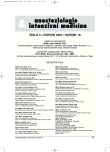-
Medical journals
- Career
Early resuscitation of septic shock to different levels of arterial blood pressure
Authors: P. Suk 1; J. Hruda 1; X. Leverve 2; V. Šrámek 1
Authors‘ workplace: Anesteziologicko-resuscitační klinika, Fakultní nemocnice u sv. Anny v Brně 1; LBFA-INSERM E221, Université J. Fourier, Grenoble, France 2
Published in: Anest. intenziv. Med., 18, 2007, č. 3, s. 150-156
Category: Intensive Care Medicine - Original Paper
Overview
Objective:
The optimal target mean arterial pressure (MAP) in the resuscitation of septic shock is undetermined. The aim of this study was to assess the effect of different levels of MAP on splanchnic organ perfusion/ function and lactate metabolism.Design:
Prospective, randomized, clinical trial.Setting:
St. Anna University Hospital, Brno, Department of Anaesthesia and Intensive Care.Materials and methods:
Patients in the first 6 hours of septic shock were randomized to target MAP of 65 (G65) or 85 (G85) mm Hg. The target MAP was achieved by the admisnistration of fluids and norepinephrine. A set of measurements was taken during the first 2 hours of the study (T1) and repeated 6 hours later (T2). Lactate metabolism was assessed by the exogenous lactate challenge test (ELCT). Cardiac output (CO), SvO₂, gastric tonometry (pCO₂gap), clearance of ICG (ICG-PDR) and creatinine clearance were measured. The data are presented as median (range); appropriate non-parametric tests were used.Results:
16 patients were included in the study – 8 in the G65 and 8 in the G85 groups. APACHE II and SOFA scores were comparable between the groups. Patients randomized to G65 tended to higher age than G85 (p = 0.065). No differences in the volume of infused fluids, norepinephrine dose, CI and SvO₂ were observed during the study. Values of pCO₂gap, ICG-PDR and creatinine clearance did not differ between the groups at T1 or T2. No differences in lactate production and elimination were recorded but the G65 patients tended to an increased lactate turnover between T1 and T2.Conclusion:
Resuscitation of septic shock patients to different MAP level (65 or 85 mm Hg) did not influence the global or splanchnic haemodynamics or lactate metabolism.Key words:
septic shock – norepinephrine – perfusion pressure – lactate – haemodynamics
Labels
Anaesthesiology, Resuscitation and Inten Intensive Care Medicine
Article was published inAnaesthesiology and Intensive Care Medicine

2007 Issue 3-
All articles in this issue
- Altering the hemodynamics during abdominal aortic aneurysm repair by acute normovolemic hemodilution
- Early resuscitation of septic shock to different levels of arterial blood pressure
- Impact of addition of synbiotics (Synbiotic 2000 Forte) to enteral nutrition on the course of MODS, occurrence of sepsis, immune status and gut function in long-term critically ill patients
- Extended immunologic profile taken during the first days in the ICU and the prognosis of patients requiring long-term intensive care
- Monocyte activation during the first days in the ICU and survival in a heterogeneous group of patients requiring long-term intensive care
- Helium and its role in current medicine
- The evolution of airway management
- Anaesthesiology and Intensive Care Medicine
- Journal archive
- Current issue
- Online only
- About the journal
Most read in this issue- Helium and its role in current medicine
- The evolution of airway management
- Altering the hemodynamics during abdominal aortic aneurysm repair by acute normovolemic hemodilution
- Impact of addition of synbiotics (Synbiotic 2000 Forte) to enteral nutrition on the course of MODS, occurrence of sepsis, immune status and gut function in long-term critically ill patients
Login#ADS_BOTTOM_SCRIPTS#Forgotten passwordEnter the email address that you registered with. We will send you instructions on how to set a new password.
- Career

